There are many towns inUmbria marked by the presence of Perugino (Pietro Vannucci; Città della Pieve, 1445 - Fontignano, 1523). No region more than Umbria bears the traces of the great artist: known as a pupil of Verrocchio and especially as a master of Raphael, Perugino was actually one of the greatest artists of the Renaissance. After training in the land of his birth, with an apprenticeship that allowed him to observe the works of the great artists who were preserved in Perugia (from Beato Angelico to Piero della Francesca, from Domenico Veneziano to Benozzo Gozzoli), Perugino first looked to his contemporaries, above all Benedetto Bonfigli and Bartolomeo Caporali, and then moved to Florence where, as mentioned, he was a pupil of Verrocchio and studied together with Leonardo da Vinci and Sandro Botticelli. His experiences enabled him to develop an original and innovative language, which was based on solid drawing, the noble and delicate grace of his characters, and attention to detail, especially in the rendering of landscapes, which almost never lacked references to his land (in fact, Lake Trasimeno, which was very dear to him, is often seen). It was such a peculiar style that he immediately had imitators all over Italy: it was the first time that the art of a Renaissance painter had imposed itself with such widespread and widespread success. There is no better way to get to know Perugino’s art than to go to Umbria for a tour among the places that preserve his works: we therefore propose below an itinerary in 10 stages to see all the artist’s production in the region where he was born.
The journey can only start from Perugia, where the bulk of his production is collected. No city in the world preserves as much evidence of Perugino’s art as the Umbrian capital. Moreover, Perugia is one of only three cities (the others are Rome and Florence) where it is possible to see both works by Perugino housed at museum venues and works that still stand in the places for which they were conceived. For an all-encompassing overview of Pietro Vannucci’s art, the first stop can only be the National Gallery of Umbria, in Palazzo dei Priori: here the largest and most important nucleus of Perugino’s works in the world is kept, from early works such as the Gonfalone del Farneto or the panels of San Bernardino, through a masterpiece that is also juvenile such as theAdoration of the Magi and the works of his maturity (such as the Madonna of the Confraternity of Consolation, the Tezi Altarpiece, theRanieri Annunciation and the Banner of Justice) to late works such as the Monteripido Altarpiece and the Polyptych of St. Augustine. We then descend to the first floor of Palazzo dei Priori, in the seat of the Collegio del Cambio, to admire the sumptuous cycle of frescoes with which Perugino decorated the Sala delle Udienze between 1496 and 1500. We then go to the nearby Chapel of San Severo, where it is possible to see the Trinity with Six Saints, one of his extreme works (from 1521), the only one, however, in which Perugino is placed in direct comparison with his pupil Raphael, since Pietro Vannucci was called upon to complete the work left unfinished by the Urbino. The Museo del Capitolo is also worth a visit: there are no works by Perugino here, but the museum has a room dedicated to the Holy Ring of Perugia Cathedral, for whose chapel the artist painted the Wedding of the Virgin, which is now at the Musée des Beaux-Arts in Caen, France.

From Perugia we move on to Deruta, to visit the Pinacoteca Comunale: the small museum in the city of ceramics houses a detached fresco (it was formerly in the church of San Francesco) depicting the Eternal Father with Saints Rocco and Romano, painted by Perugino between 1477 and 1478. The work is special because, below the two saints, Rocco and Romano, it is possible to observe a view of the city of Deruta as it was in the 15th century, at the time when the painter waited to create his work: it is in that position so that it can receive the protection of the two saints. The fresco was in fact painted as an ex voto following a plague that struck the city in 1476: the two saints are in fact invoked as protectors against disease. It is one of the most significant works from the early phase of Perugino’s career.
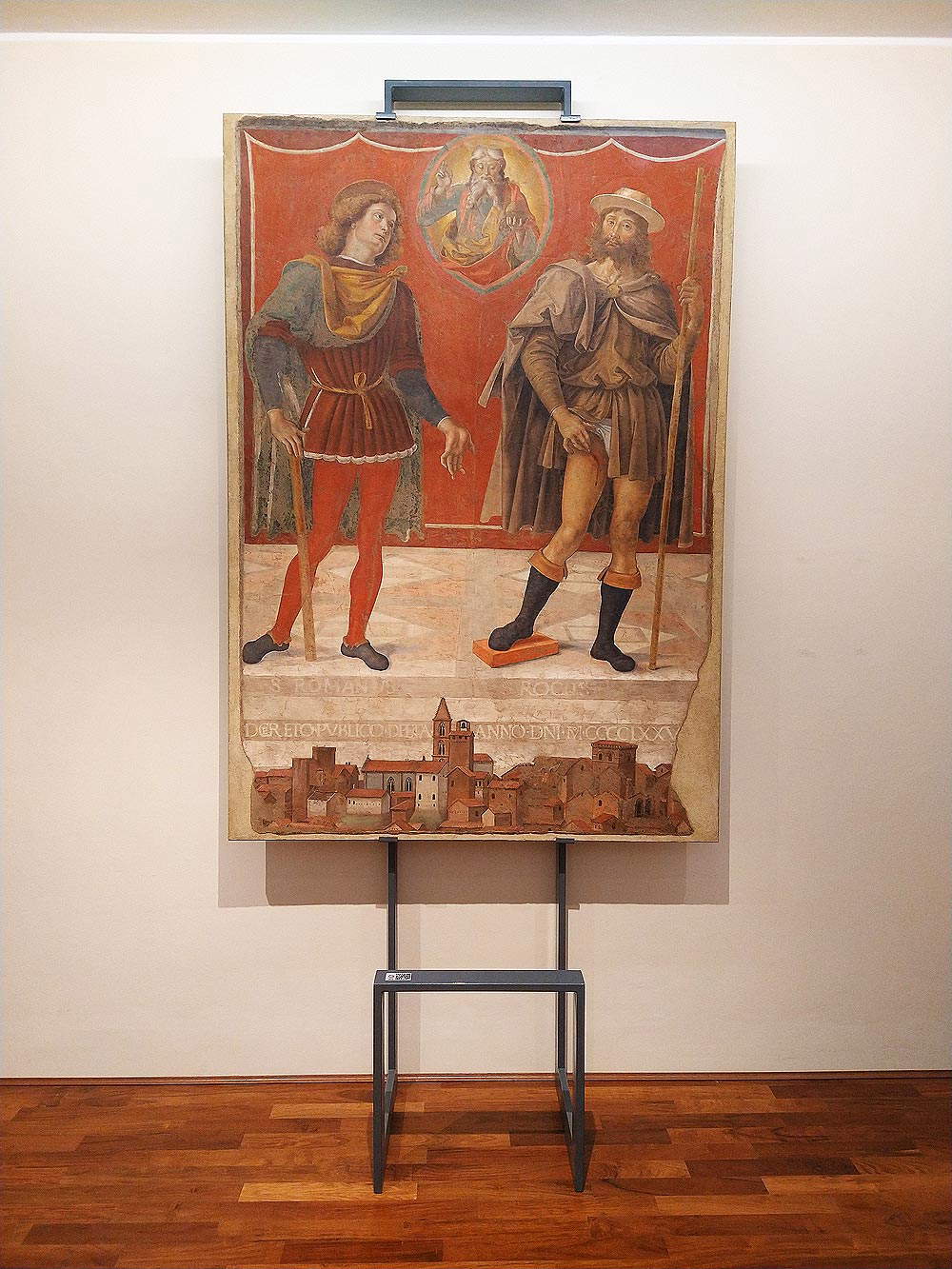
Not far from Deruta, in the village of Cerqueto, it is possible to visit the church of Santa Maria Assunta, where a fragmentary fresco by Perugino, painted in 1478 and depicting Saint Sebastian between Saints Rocco and Peter, is kept. The work dates from the period when the artist had returned to Umbria from Florence, where he had gone to study from Verrocchio: the frescoes in the church of Cerqueto, of which unfortunately only fragments remain today, were one of the first large-scale commissions for the artist, who tried his hand here at a complex cycle, again commissioned after the end of the plague of 1476. The only fully legible saint is Saint Sebastian, another deity invoked against disease, who is influenced by the art of Piero della Francesca. Perugino would later replicate the figure of the martyr saint several other times: at Cerqueto, however, it is possible to see the prototype of many other similar figures.
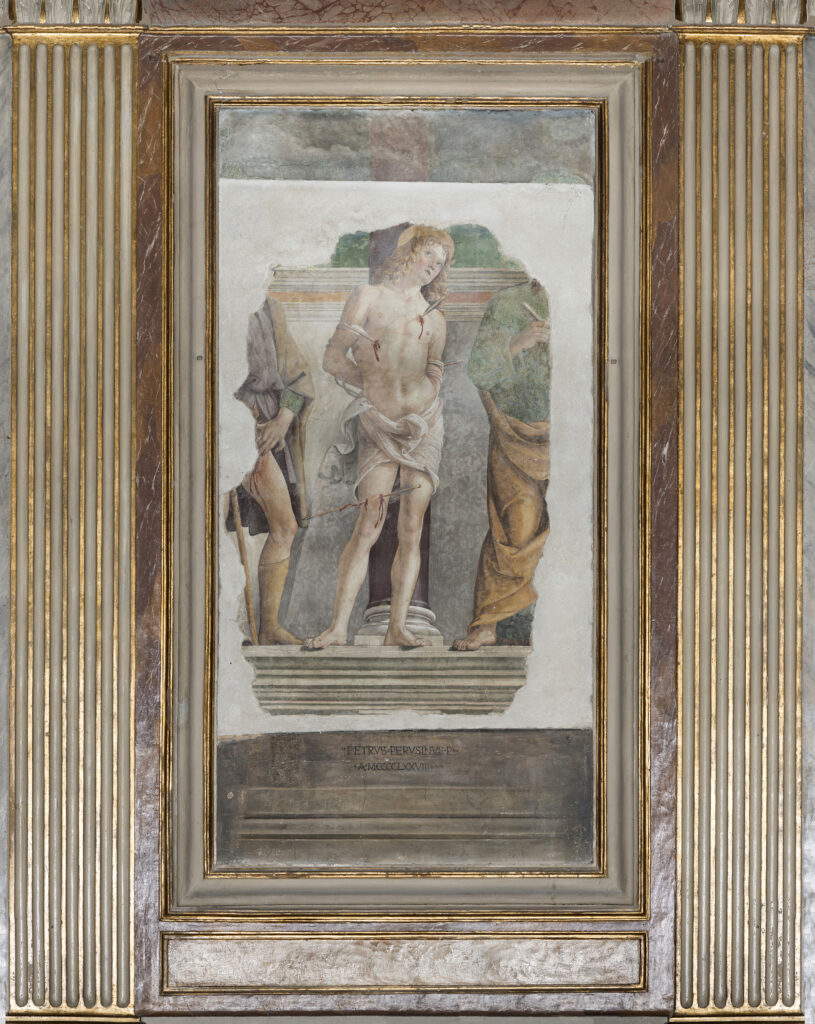
In the complex of San Francesco in Montefalco it is possible to admire a monumental fresco from the mature phase of Perugino’s career, the Nativity, in which the artist takes up, simplifying it, the same scheme of the Nativity that he had painted in one of the lunettes of the Collegio del Cambio in Perugia. Perugino’s fresco dates from 1503 (it was commissioned from him by Friar Francesco Augusti, a Friar Minor Conventual, professor of sacred scripture, theologian and, above all, guardian of the Convent of St. Francis), and was painted by him on the counter-façade of the Church of St. Francis, which today has been converted into a museum complex. In the lunette above the scene of the Nativity, Pietro Vannucci then painted another of the typical figures in his repertoire, the Padreterno in a mandorla, who appears accompanied by two kneeling angels. In the arch here instead is anAnnunciation. The peculiarity of the work is then the faux architecture within which the scenes are framed, excellently preserved, with a singular cross-reference between content and container since the grotesques of the faux columns are identical to those of the columns of the hut under which the scene takes place.
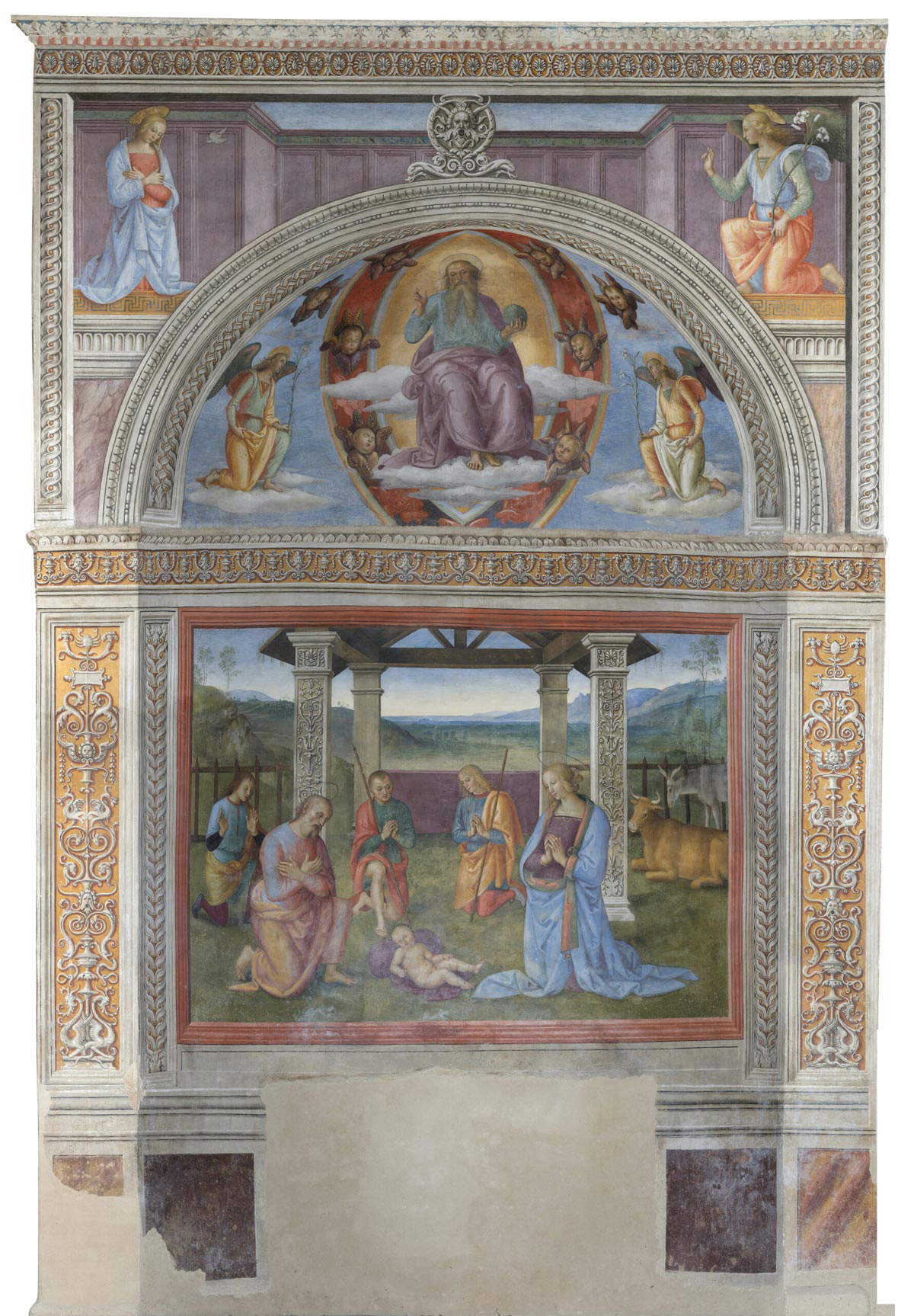
On a tour of Perugino’s Umbria, a stop in his hometown of Città della Pieve is a must, where there are three places to visit. One first goes to theOratory of Santa Maria dei Bianchi, where a masterpiece such as theAdoration of the Magi from 1504, painted precisely for the oratory (a curiosity: Perugino worked at a heavily discounted price precisely because the work was destined for his town), is preserved, and which also echoes the Nativity of the Collegio del Cambio. A short walk away we then visit the Cathedral of Saints Gervasius and Protasius, where two works by Perugino can be seen: the panel painting with the Baptism of Christ, executed around 1510 for the chapel dedicated to St. John the Baptist, and the Madonna Enthroned between Saints Gervasius Protasius (from 1507), which today stands in the central part of the apse but was originally intended for the high altar because it was the most important of the church, since it depicts Our Lady in glory together with the two titular saints of the pievese cathedral (as well as patrons of the city, so much so that they hold the banners with the symbol of the city, which at that time was still not called “Città della Pieve” since it was elevated to a city only in the 17th century by Pope Clement VII, but was called “Castello della Pieve,” “Castrum Plebis” in Latin). Finally, in the church of Santa Maria dei Servi, now a museum, one can admire the two fragmentary and little-known frescoes of the Deposition of Christ and the Lamentation over the Dead Christ, commissioned in 1517 from Perugino by the Compagnia della Stella.
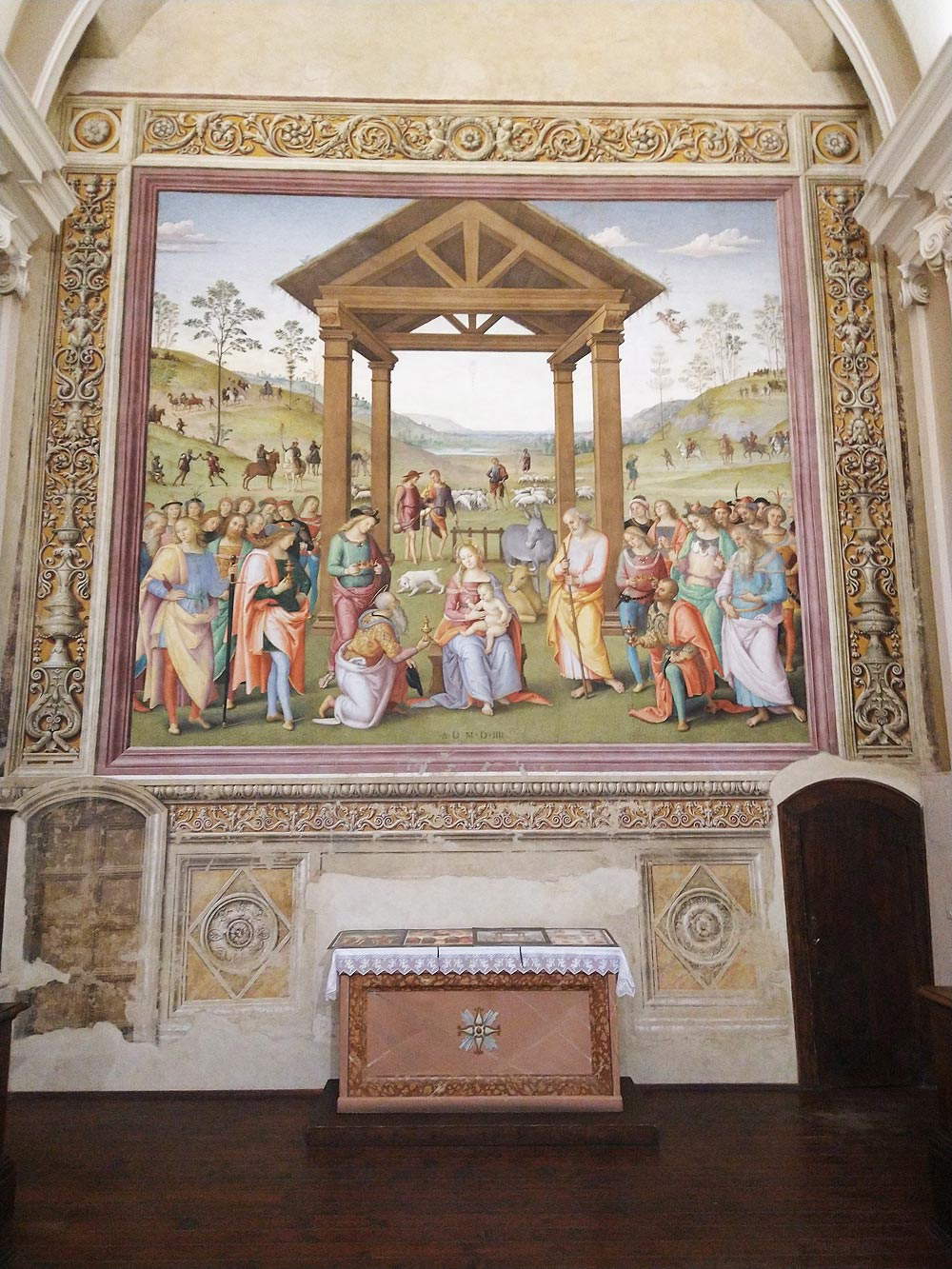
Outside the walls of the pretty village of Panicale is the church of San Sebastiano, a visit to which is a must on a trip to discover Perugino in Umbria, for two reasons. The first is the fresco, circa 1505, with the Martyrdom of St. Sebastian, which is also special because the scene takes place in front of an airy, monumental classical portico decorated with grotesques, open to an Umbrian landscape painted in aerial perspective, under the apparition of the Eternal Father in the mandorla, accompanied by the two symmetrical angels. The second motif is a detached fresco that has fascinated and continues to fascinate scholars: long thought to be of the Perugia school, it was attributed by Elvio Lunghi in 2005 to the young Raphael. However, we do not know for sure whether this Madonna and Child is really the work of Raphael, but it is certainly another good reason to visit this amazing place.

One of Perugino’s most sumptuous and spectacular works can be found in Corciano, in the church of Santa Maria: it is the monumental Corciano Altarpiece, a work more than two meters high, enclosed in a sumptuous frame, depicting theAssumption of the Virgin, whom we see taken to heaven accompanied by ringing angels and seraphim, within a mandorla, with the apostles in the lower register watching the event ecstatically. The altarpiece, executed in 1513, replicates elements already well tried and tested by the artist and his workshop, but the Corciano Altarpiece stands out, even compared to other works by the late Perugino, for the very high quality of the pictorial drafting and the finesse of the drawing. Another peculiarity is the fact that this painting is still in the place for which it was conceived, an occurrence not so obvious for an altarpiece by Perugino destined for an Umbrian church, since most of them are preserved in museums today.
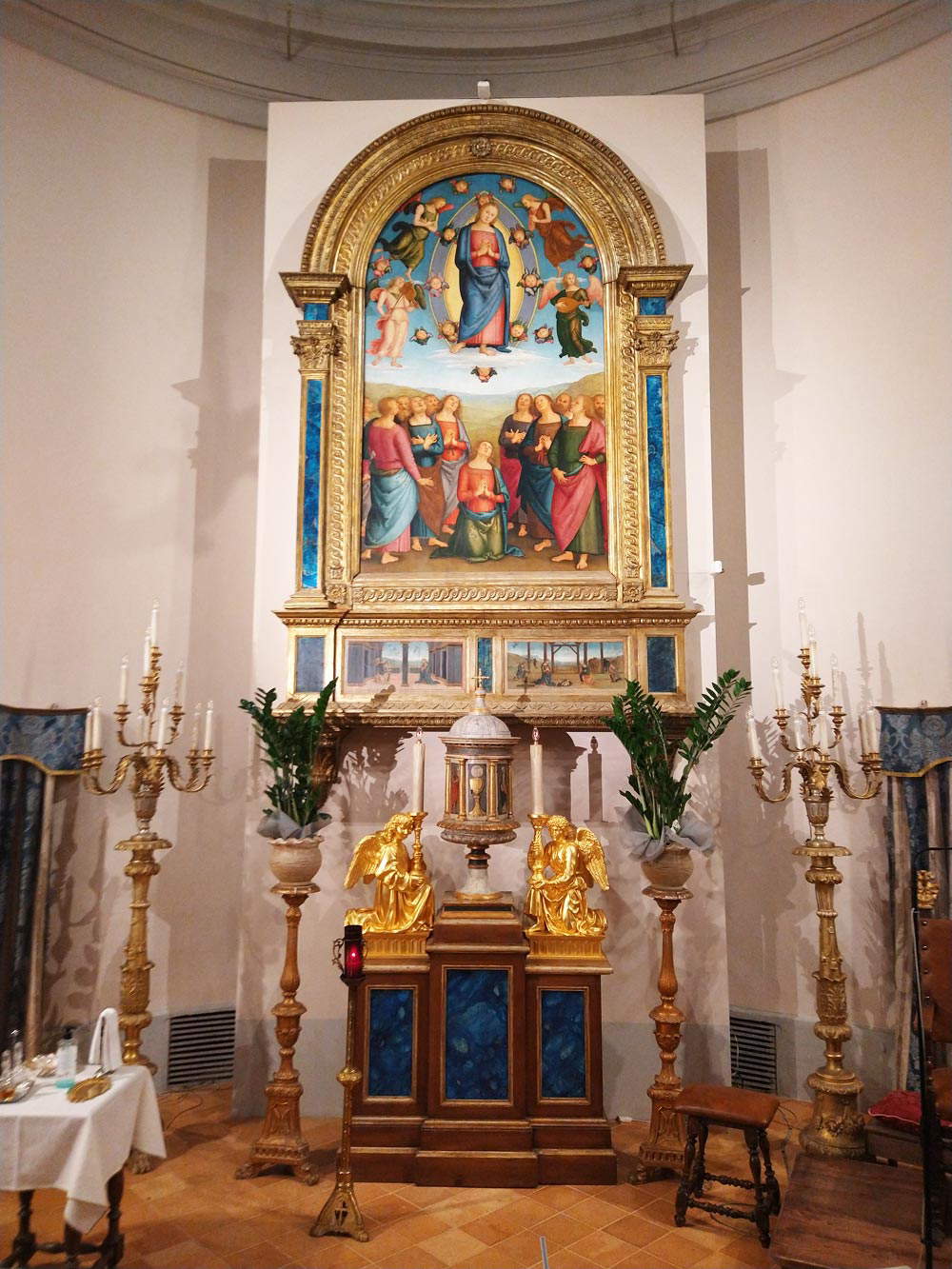
The Pinacoteca Comunale di Bettona preserves three works by Perugino from the 1910s. The first is a panel painting of St. Anthony of Padua, an ex voto in which we also see represented the commissioner (Bartolomeo di Maraglia, lieutenant of the lord of Perugia Giampaolo Baglioni, who had been captured and imprisoned after the battle of Marignano and had prayed to St. Anthony to be freed). The second is Our Lady of Mercy, which probably originally decorated a shrine in the Umbrian countryside, only to be moved in 1987 to the church of St. Anthony in Bettona. It was then stolen in 1987 and was even found in Jamaica: returned to Italy, it was restored and then transferred to the museum in Bettona. Finally, the third work is the Gonfalone di Sant’Anna, a work attributed to Perugino and his workshop, where a depiction of the town of Bettona can be seen in the background.
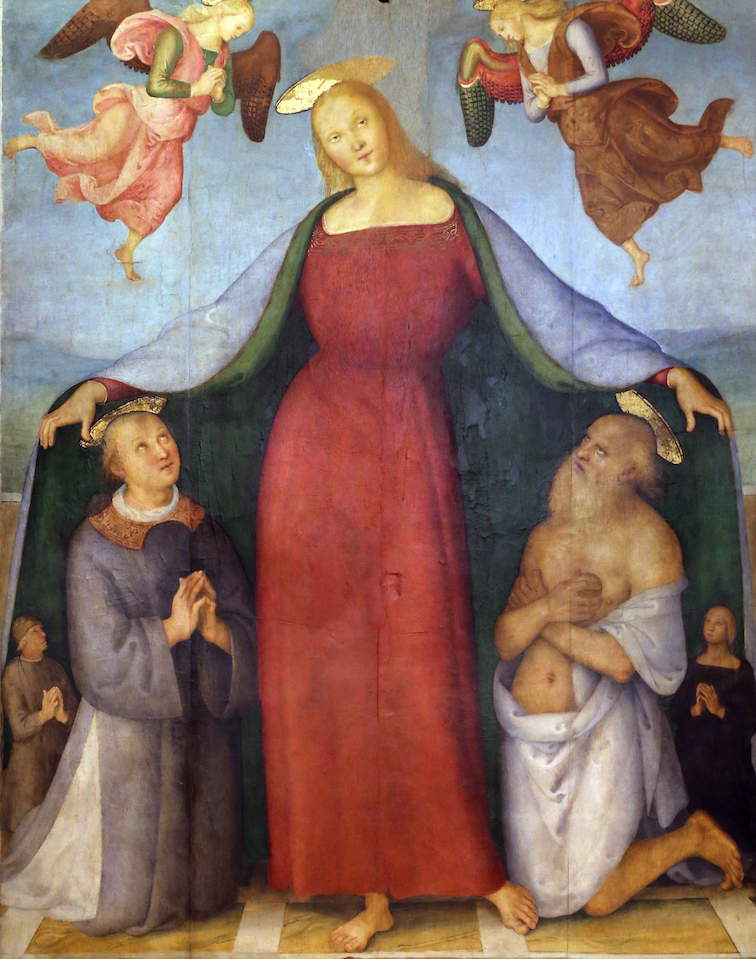
The journey ends in the eastern part of the province of Perugia, beginning in the beautiful town of Spello. Here, in the church of Santa Maria Maggiore, we encounter two late works by Perugino. The first is a Pietà with St. John the Evangelist and Mary Magdalene, a work from 1521 of which we know the name of the commissioner (a certain Michelangelo Andine), since his name appears in the dedicatory inscription. The second work, also dating from 1521, is a Madonna and Child, Saint Catherine of Alexandria and Saint Blaise, commissioned by a Giovanni Bernardelli also mentioned in the inscription we note on the Virgin’s throne. These are works that repeat the same scheme, so much so that even the Pietà is set above a throne similar to that of the work executed for Giovanni Bernardelli, and the two saints on the right (Magdalene and Catherine of Alexandria) have identical faces, executed on the basis of the same cartoon. Of great finesse, and well preserved, is the landscape we notice behind the Pietà, with a masterful aerial perspective that blurs the rolling hills of Umbria into the distance.

The last stop on the trip is Foligno: in theOratorio della Nunziatella, the altar of St. John the Baptist has a fresco by Perugino depicting the Baptism of Christ, exemplified on the same scheme as the one painted for Città della Pieve and the one that appears in the Polyptych of St. Augustine preserved at the National Gallery of Umbria in Perugia. We do not know the exact date of its completion (perhaps the period between 1505 and 1508 or 1512-1513). Another work typical of Perugino’s last phase, like many other sacred-themed works by the artist it finds its setting not in the places of the Holy Scriptures, but in the painter’s native Umbria. The Baptism of Christ is surmounted by a lunette where again Perugino painted another fresco, depicting the Eternal Father among adoring angels.

 |
| Perugino in Umbria, what to see: 10 places that preserve his works |
Warning: the translation into English of the original Italian article was created using automatic tools. We undertake to review all articles, but we do not guarantee the total absence of inaccuracies in the translation due to the program. You can find the original by clicking on the ITA button. If you find any mistake,please contact us.